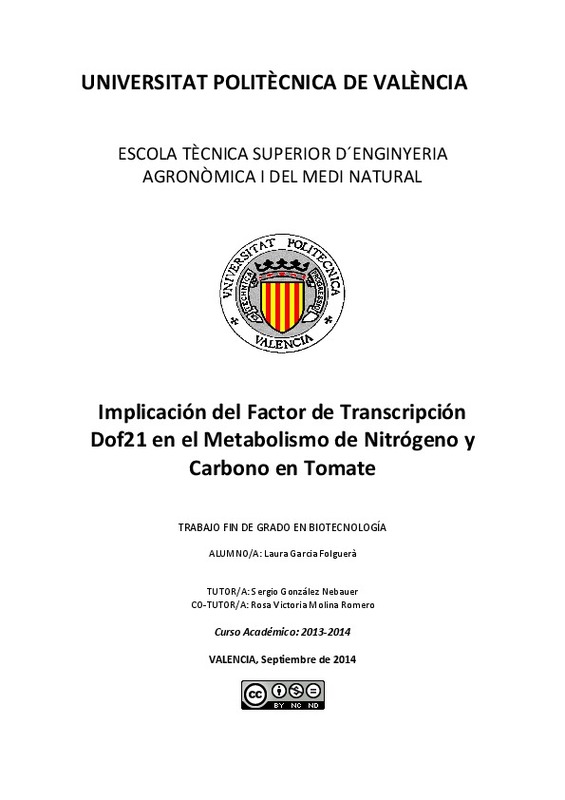|
Resumen:
|
[ES] Durante el siglo XX, la mejora de la producción de los cultivo se basó en la optimización de las prácticas de cultivo, incluyendo fertilizantes, pesticidas, riego, y la selección de cultivares. Actualmente, la creciente ...[+]
[ES] Durante el siglo XX, la mejora de la producción de los cultivo se basó en la optimización de las prácticas de cultivo, incluyendo fertilizantes, pesticidas, riego, y la selección de cultivares. Actualmente, la creciente demanda de producción, junto con la limitación en la disponibilidad de tierras y agua de riego de calidad, hace necesario el desarrollo de nuevas variedades con una capacidad mayor de producción de biomasa y tolerancia a estreses ambientales. Además, en el contexto de una agricultura sostenible y menos agresiva con el medio ambiente, es necesario reducir el uso de fertilizantes. En este sentido, estas variedades deben presentar una mejor eficiencia en el uso del nitrógeno, uno de los principales macronutrientes requeridos por la planta y responsable de la contaminación de acuíferos.
La generación de plantas transgénicas con mayor capacidad de producción de biomasa por sobreexpresión de genes individuales relacionados con la fijación fotosintética de carbono o la asimilación de nitrógeno ha dado resultados limitados, ya que se trata de caracteres multigénicos. En este sentido, la utilización de factores de transcripción, que regulan la expresión de múltiples genes simultáneamente, parece una estrategia prometedora. La sobreexpresión de genes de una familia de factores de transcripción específicos de plantas, los genes Dof (DNA-binding with one finger), han incrementado la producción en plantas de maíz o mijo.
En el presente trabajo se ha caracterizado el papel del gen Dof21 de Arabidopsis thaliana en el metabolismo de carbono y nitrógeno en tomate. Para ello se han cultivado plantas en condiciones de invernadero, con tres niveles de aporte de nitrógeno (100, 60 y 30% del aporte completo), y se ha determinado la producción de biomasa, la capacidad fotosintética, el contenido en carbohidratos metabolizables, el contenido total en C y N, así como la actividad enzimática de la enzima nitrato reductasa y la expresión del gen PEP carboxilasa y la quinasa SnRK1.
La sobreexpresión del gen Dof21 incrementa la tasa fotosintética, la disponibilidad de carbohidratos y la producción de tomate. Aunque estas plantas no tienen un mayor contenido en N, su ratio C/N es superior debido al mayor contenido en C. Además, en condiciones de limitación en el aporte de nitrógeno, las sobreexpresoras del gen Dof21 mantienen esta relación C/N así como la producción de biomasa y de fruto. Incluso la producción de fruto en estas condiciones limitantes es superior al de las plantas no transformadas en condiciones de aporte completo de nitrógeno. Los resultados obtenidos en el presente trabajo muestran la utilidad de los factores de tipo Dof en ingeniería metabólica, en la mejora de la producción de cultivos a través de sus múltiples efectos sobre el metabolismo de las plantas.
[-]
[EN] During the 20th century, the improvement in the crop production was based on the optimization of the growing techniques, including fertilisers, pesticides, irrigation and cultivars selection. Currently, the increasing ...[+]
[EN] During the 20th century, the improvement in the crop production was based on the optimization of the growing techniques, including fertilisers, pesticides, irrigation and cultivars selection. Currently, the increasing demand in production along with the limitation of land and irrigation water availability makes it necessary the development of new varieties with a greater capacity of biomass production and environmental stress tolerance. Furthermore, in the context of a sustainable and less aggressive agriculture, it is essential to reduce the fertilisers used. Accordingly, these new varieties should be more efficiency regarding the use of nitrogen, which is one of the principal macronutrients required by the plant and responsible of the aquifer contamination.
The generation of transgenic plants with an increased biomass production capacity through the overexpression of genes related to the photosynthetic fixation of carbon or the nitrogen assimilation has provided limited results, due to the fact that these are multigenic characters. In this regard, the utilization of transcription factors, which regulate the expression of multiple genes simultaneously, could be a promising strategy. The overexpression of a specific plant family of transcription factors, the Dof (DNA-binding with one finger), has increased the production in maize, millet plants.
In the present study, it has been characterized the role of the Arabidopsis thaliana gen Dof21 in the carbon and nitrogen metabolism in tomato. For this purpose, tomato plants have been cultivated in greenhouse conditions with three levels of nitrogen input (100, 60 and 30% of the full input). Finally, it has been determinated the biomass production, the photosynthetic capacity, the metabolizable carbohydrates content, the carbon and nitrogen content, the activity of the nitrate reductase enzyme and the expression of PEP carboxylase and the kinase SnRK1.
The Dof21 overexpression increases the photosynthetic rate, the availability of carbohydrates and the production of tomato. Although these plants have not shown an increase in their nitrogen content, their C/N ratio is higher due to an increase of the C content. Moreover, in conditions of limited nitrogen input, the transgenic plants remain the relation C/N and the biomass and fruit production. Even the fruit production is higher in these nitrogen limitating conditions in contrast to the not transformed plants grown in conditions of complete nitrogen input. The results obtained in this study shown that the use of Dof transcription factors is a promising strategy in metabolic engineering. Particularly, in the improvement of crop production due to their multiple effects on the plant metabolism.
[-]
|







